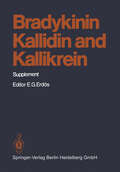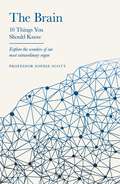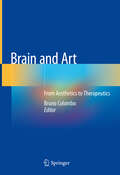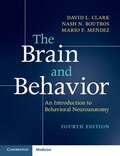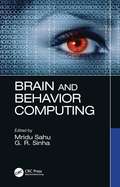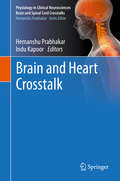- Table View
- List View
Bradley's Neurology in Clinical Practice E-Book
by Joseph Jankovic John C Mazziotta Scott L PomeroyA practical, dynamic resource for practicing neurologists, clinicians and trainees, Bradley and Daroff's Neurology in Clinical Practice, Eighth Edition, offers a straightforward style, evidence-based information, and robust interactive content supplemented by treatment algorithms and images to keep you up to date with all that's current in this fast-changing field. This two-volume set is ideal for daily reference, featuring a unique organization by presenting symptom/sign and by specific disease entities—allowing you to access content in ways that mirror how you practice. More than 150 expert contributors, led by Drs. Joseph Jankovic, John C. Mazziotta, Scott L. Pomeroy, and Nancy J. Newman, provide up-to-date guidance that equips you to effectively diagnose and manage the full range of neurological disorders. - Covers all aspects of today's neurology in an easy-to-read, clinically relevant manner. - Allows for easy searches through an intuitive organization by both symptom and grouping of diseases. - Features new and expanded content on movement disorders, genetic and immunologic disorders, tropical neurology, neuro-ophthalmology and neuro-otology, palliative care, pediatric neurology, and new and emerging therapies. - Offers even more detailed videos that depict how neurological disorders manifest, including EEG and seizures, deep brain stimulation for PD and tremor, sleep disorders, movement disorders, ocular oscillations, EMG evaluation, cranial neuropathies, and disorders of upper and lower motor neurons, as well as other neurologic signs. - Enhanced eBook version included with purchase. Your enhanced eBook allows you to access all of the text, figures, and references from the book on a variety of devices.
Bradykinin, Kallidin and Kallikrein: Supplement (Handbook of Experimental Pharmacology #25 / 1)
by K. D. Bhoola W. G. Clark R. W. Colman E. G. Erdös F. Fiedler T. L. Goodfriend L. M. Greenbaum A. R. Johnson M. Lemon A. P. Levitskiy H. S. Margolins R. Matthews I. H. Mills H. Z. Movat C. E. Odya T. S. Paskhina J. J. Pisano J. M. Stewart R. C. Talamo A. Terragno N. A. Terragno R. Vogel P. E. Ward P. Y. WongVolume XXV of the Handbook of Experimental Pharmacology series entitled "Bradykinin, Kallidin, and Kallikrein" was published in 1970. My aim in editing this volume of the series is not to replace, but to update the 1970 edition. During the decade preceding the publication of Vol. XXV, the existence of kinins and kallikreins gained acceptance, the protein components of the system were purified and characterized and the peptides were synthesized. Even after these accomplish ments, interest in the subject has not abated, but has increased substantially. We have learned a great deal about the role that components of the kallikrein-kinin system play in other systems and about the immensely complex and intricate inter actions in blood. Directly or indirectly, kallikrein and kinins affect the coagulation of blood, the activation of complement, and the generation of angiotensin. Kinins release or modulate the actions of other agents, including prostaglandins, histamine, and catecholamines. Inhibitors of kallikrein or kininase II are employed, for example, in extracorporeal circulation or in hypertension. Kallikrein, kinins, and kininases, present in urine, were described first in 1925 and 1954, but have been ignored for decades. These substances are now studied extensively because of their possible role in blood pressure regulation. The evidence that kinins have a metabolic function is also increasing. The abundance of active components of the system in genital organs suggests a role in the fertilization process. The book is organized into chapters which bear upon these issues.
Bradykinin, Kallidin and Kallikrein (Handbook of Experimental Pharmacology #25 / 2)
by Ervin G. Erdös Anne F. WildeBradykinin is frequently referred to as an elusive substance; the editor of a comprehensive volume dealing with kinins thus has a difficult task. The com plexity of the issues calls for a large number of contributors who approach the topics from the various angles that are dictated by the sometimes divergent views of the individuals. The editor saw no reason to prescribe the mode of presentation, which was left to the authors and accounts for the variety of approaches. Contributors from nine countries were asked to participate in the volume. The chapters were organized to present, first, the history of the discoveries and methods of approach to kinin research. Then follows a discussion of the enzymes that release kinins, their substrates, and other enzymes that inactivate the peptides. If the release of kinin is important, then the inhibition of the releasing enzymes is of obvious interest and is described. Since the measurement of kinin ogen levels in blood has been frequently used as an indicator of kinin liberation, in addition to a separate chapter, kininogens are also mentioned where the functions of kinins are discussed. The conclusions drawn from establishing structure-action relationships for many analogs and the actions of kinins are indicated and summarized.
BRAF Targets in Melanoma: Biological Mechanisms, Resistance, and Drug Discovery (Cancer Drug Discovery and Development #82)
by Ryan J. SullivanThis volume contains a collection of writings from the leaders in the fields of Molecular Biology and Melanoma Research which will begin to tell the ever-expanding story of the most recent findings, discoveries, and potential of BRAF-directed targets in melanoma. Recent research has shown that BRAF inhibitors are effective for a short period of time, but there is little hope that this drugs as single agents will lead to durable benefit in a majority of patients. Among scientists and researchers who work in drug discovery, there is a lot of interest in the development of molecularly targeted cancer agents. Namely, the identification of a molecular target, the selection of molecules which effectively inhibit this target. What is starkly different about the development of this class of compounds, however, is that the mechanism of action of these agents are not as straightforward as was once previously assumed and the mechanisms of resistance that tumor cells employ to evade complete destruction are unlike any that have been described before. These discoveries in addition to utilization of modern molecular biology techniques have led to a series of hypotheses regarding which other types of molecules could be used in combination with BRAF-inhibitors in hopes of revolutionizing the potential of therapeutics in melanoma.
Brain (A\medical Thriller Ser.)
by Robin CookTwo doctors suspect something is very wrong at the enormous medical center where they work. And soon they will put their careers–and their lives–in deadly jeopardy, as they penetrate the eerie inner sanctums of a medical world gone mad.
The Brain: An Introduction to Functional Neuroanatomy
by Charles Watson Matthew Kirkcaldie George PaxinosThe authors of the most cited neuroscience publication, The Rat Brain in Stereotaxic Coordinates, have written this introductory textbook for neuroscience students. The text is clear and concise, and offers an excellent introduction to the essential concepts of neuroscience. - Based on contemporary neuroscience research rather than old-style medical school neuroanatomy - Thorough treatment of motor and sensory systems - A detailed chapter on human cerebral cortex - The neuroscience of consciousness, memory, emotion, brain injury, and mental illness - A comprehensive chapter on brain development - A summary of the techniques of brain research - A detailed glossary of neuroscience terms - Illustrated with over 130 color photographs and diagrams This book will inspire and inform students of neuroscience. It is designed for beginning students in the health sciences, including psychology, nursing, biology, and medicine. - Clearly and concisely written for easy comprehension by beginning students - Based on contemporary neuroscience research rather than the concepts of old-style medical school neuroanatomy - Thorough treatment of motor and sensory systems - A detailed chapter on human cerebral cortex - Discussion of the neuroscience of conscience, memory, cognitive function, brain injury, and mental illness - A comprehensive chapter on brain development - A summary of the techniques of brain research - A detailed glossary of neuroscience terms - Illustrated with over 100 color photographs and diagrams
The Brain: 10 Things You Should Know
by Professor Sophie ScottUncover the mind-blowing complexities of the brain and how it affects our personalities, behaviours and more.Written by Professor of Cognitive Neuroscience at UCL, Sophie Scott, and composed of ten mind-blowing yet accessible essays, The Brain guides you through the astounding complexities of the organ that makes you, you. From diving into the networks of neurons that are vital to our functioning, to the way our brains differ from one another and how neuroscience is shaping up for the future; this book is a guide to our most powerful and awe-inspiring body part.If you have ever wondered what's going on inside your head (or someone else's), this book will be a fascinating and enthralling read.
Brain Abscess and Meningitis: Subarachnoid Hemorrhage: Timing Problems (Advances in Neurosurgery #9)
by W. Schiefer, M. Klinger and M. BrackW. SCHIEFER The 31st annual meeting of the Deutsche Gesellschaft für Neurochirurgie was held in Erlangen on May 1 - 4,1980. The numerous participants obviously enjoyed the opportunity to be co me acquainted with the attractive city of gardens, lecture theatres and workshops surrounded by a lovely countryside and a historic environment. The pro gram included a visit to the neighboring city of Nürnberg, to the old Reichsstadt Regensburg and an opening ceremony in the orangerie of the Erlangen palace, where the "Bamberger Ensemble für alte Musik" presented interesting and little-known early music. The annual meeting was held in the newly-built "Kopfklinik" of the University of Erlangen-Nürnberg, which houses the departments of neurosurgery, neurology and ophthalmology. As far as possible, many functions of this hospital were centralized because this has economic advantages and saves personell. Other functional units, such as the operating theatres, the intensive care units, research laboratories and units specific to the individual disciplines remained decentralized and independent. This concept has proved to be a happy solution. At the membership meeting of the Deutsche Gesellschaft für Neurochirurgie, Prof. Dr. K. J. Zülch of Cologne was made an honorary member of this society, of which he is a founding member.
Brain Aging and Therapeutic Interventions
by Mahendra K. Thakur and Suresh I.S. RattanThis book brings together most up-to-date information on different aspects of brain aging and on the strategies for intervention and therapy of age-related brain disorders. It includes 18 chapters by leading researchers, and each chapter is a comprehensive and critical review of the topic in question, discusses the current scenario and focuses on future perspectives. The target readership is the undergraduate and graduate students in the universities, in medical and nursing colleges, along with the post-graduate researchers and practicing clinicians who would like to know about the latest developments in the field of neurodegenerative disorders and their therapeutic interventions. This book will be of much interest to pharmaceutical, nutrition and healthcare industry for an easy access to accurate and reliable information in the field of aging research and intervention.
Brain Anatomy and Magnetic Resonance Imaging
by GeorgesSalamon AndréGouazeWith the collaboration of numerous experts. Proceedings of an International Meeting Held in Marseille, September 26-27, 1987
Brain Anatomy and Neurosurgical Approaches: A Practical, Illustrated, Easy-to-Use Guide
by Eberval Gadelha Figueiredo Nícollas Nunes Rabelo Leonardo Christiaan WellingThis strategic book joins the classical brain anatomy to the challenges of neurosurgery approaches. Its thirty illustrated chapters connect basic concepts to the specialists experience in the operating room. They also provide didactic tips and tricks for accessing the brain into to the surface, cisterns, central core, ventricles and skull base. The Brain Anatomy and Neurosurgical Approaches is focused on neurosurgeons in training and those who need updated information and technical tips on how to deal with neurosurgical patients, as well as with anatomical challenges in real surgeries. Neurosurgeons, residents and students will have a helpful source of study and research.
Brain and Art: From Aesthetics to Therapeutics
by Bruno ColomboThis book analyzes and discusses in detail art therapy, a specific tool used to sustain health in affective developments, rehabilitation, motor skills and cognitive functions. Art therapy is based on the assumption that the process of making art (music, dance, painting) sparks emotions and enhances brain activity. Art therapy is used to encourage personal growth, facilitate particular brain areas or activity patterns, and improve neural connectivity. Treating neurological diseases using artistic strategies offers us a unique option for engaging brain structural networks that enhance the brain’s ability to form new connections. Based on brain plasticity, art therapy has the potential to increase our repertoire for treating neurological diseases. Neural substrates are the basis of complex emotions relative to art experiences, and involve a widespread activation of cognitive and motor systems. Accordingly, art therapy has the capacity to modulate behavior, cognition, attention and movement. In this context, art therapy can offer effective tools for improving general well-being, quality of life and motivation in connection with neurological diseases. The book discusses art therapy as a potential group of techniques for the treatment of neurological disturbances and approaches the relationship between humanistic disciplines and neurology from a holistic perspective, reflecting the growing interest in this interconnection.
The Brain And Behavior: An Introduction To Behavioral Neuroanatomy (pdf)
by David L. Clarke Nash N. Boutros Mario F. MendezNow in its fourth edition, The Brain and Behavior introduces the field of neurobiology of human behavior to a wide audience, from graduate students to professionals in the fields of psychology, psychiatry, and neurology. This comprehensive resource focuses on locating human behaviors to specific regions of the brain, aiming to make a complex topic visually accessible through the inclusion of clear and focused illustrations. This important new edition emphasises recent developments in our understanding of the human brain which have emerged from imaging studies. The text also features patient case histories with documented anatomical evidence, tying the science with actual clinical examples, making it the most accessible book for medical practitioners of all levels. The collaboration between a neuropsychiatrist, a behavioral neurologist, and a neuroanatomist has resulted in a book which synthesizes the complex and evolving information on the neurobiology of human behavior, and presents it in an eminently readable volume. This new fourth edition has been completely revised and updated Highlights the basis of psychiatric disturbances which allows clinicians to explain to the patient the source of their symptoms Simplifies complex brain anatomy making it a more accessible read than complicated in-depth texts
Brain and Behavior Computing
by Mridu SahuBrain and Behavior Computing offers insights into the functions of the human brain. This book provides an emphasis on brain and behavior computing with different modalities available such as signal processing, image processing, data sciences, statistics further it includes fundamental, mathematical model, algorithms, case studies, and future research scopes. It further illustrates brain signal sources and how the brain signal can process, manipulate, and transform in different domains allowing researchers and professionals to extract information about the physiological condition of the brain. Emphasizes real challenges in brain signal processing for a variety of applications for analysis, classification, and clustering. Discusses data sciences and its applications in brain computing visualization. Covers all the most recent tools for analysing the brain and it’s working. Describes brain modeling and all possible machine learning methods and their uses. Augments the use of data mining and machine learning to brain computer interface (BCI) devices. Includes case studies and actual simulation examples. This book is aimed at researchers, professionals, and graduate students in image processing and computer vision, biomedical engineering, signal processing, and brain and behavior computing.
Brain and Behavior Computing
by Mridu Sahu G. R. SinhaBrain and Behavior Computing offers insights into the functions of the human brain. This book provides an emphasis on brain and behavior computing with different modalities available such as signal processing, image processing, data sciences, statistics further it includes fundamental, mathematical model, algorithms, case studies, and future research scopes. It further illustrates brain signal sources and how the brain signal can process, manipulate, and transform in different domains allowing researchers and professionals to extract information about the physiological condition of the brain. Emphasizes real challenges in brain signal processing for a variety of applications for analysis, classification, and clustering. Discusses data sciences and its applications in brain computing visualization. Covers all the most recent tools for analysing the brain and it’s working. Describes brain modeling and all possible machine learning methods and their uses. Augments the use of data mining and machine learning to brain computer interface (BCI) devices. Includes case studies and actual simulation examples. This book is aimed at researchers, professionals, and graduate students in image processing and computer vision, biomedical engineering, signal processing, and brain and behavior computing.
Brain and Behavior in Child Psychiatry
by Aribert RothenbergerThe Brain-What Else! All senses are connected with the brain. From sense-perception derives . . . knowledge. In the brain is the sovereignty ofthe mind. Mind is interpreted by the brain. AIcmaeon of Croton (5th Century B. c. ) The ground is shifting under the traditional approaches to problems in the philosophy of mind. Earlier doctrines concerning the independence of cognition from the brain now appear untenable. P. S. Churchland (20th Century A. D. ) It is not objective of this volume to discuss the history and significance of neuroscience for philosophy from a developmental perspective, although this would be a rather interesting topic. Its object is the relationship between brain and behavior in children as exhibited by higher mental functions (e. g. , speech and language; reasoning, perception, free will and control of motor acts, dependence of behavior on neuronal constraints, the self of the child and therapeutic acti vi ties). Child psychiatrists commonly allude to the brain as the site of disturbance responsible for many developmental disabilities and psychopathological syn dromes identifiable by observing behavior (e. g. , dyslexia, delusions), neurological examination (e. g. , soft signs), psychological test performance (e. g. , Bender Gestalt Test), EEG (e. g. , alpha-theta ratio), and CCT (e. g. , pseudoatrophy). While there is nothing inherently wrong with such inferences, the fact is frequently overlooked that there is no specific set of brain-behavior relationships validating these inferences.
Brain and Conscious Experience: Study Week September 28 to October 4, 1964, of the Pontificia Academia Scientiarum
by John C. EcclesThe planning of this Study Week at the Pontifical Academy of Science from September 28 to October 4, 1964, began just two years before when the President, Professor Lemaitre, asked me if 1 would be responsible for a Study Week relating Psychology to what we may call the Neurosciences. 1 accepted this responsibility on the understanding that 1 could have as sistance from two colleagues in the Academy, Professors Heymans and Chagas. Besides participating in the Study Week they gave me much needed assistance and advice in the arduous and, at times, perplexing task that 1 had undertaken, and 1 gratefully acknowledge my indebtedness to them. Though there have been in recent years many symposia concerned with the so-called higher functions of the brain, for example with percep tion, learning and conditioning, and with the processing of information in the brain, there has to my knowledge been no symposium specifically with brain functions and consciousness since the memorable treating Laurentian Conference of 1953, which was later published in 1954 as the book, "Brain Mechanisms and Consciousness.
The Brain and Conscious Unity: Freud's Omega
by Petr BobIn this provocative text, a noted neuroscientist reexamines Freud's posthumously published Project of Scientific Psychology in the light of modern neuroscience. This expanded "thermodynamics of the mind" model includes robust conceptions of the cellular and neural processes that accompany creation of consciousness and memory, their contributions to such conditions as depression, dissociative disorders, and schizophrenia, and implications for practice, from imaging to talk-based therapies to pharmacotherapy. Central to this construct is Freud's proposal of specific "omega" neurons as the most volatile carriers of consciousness between mind and brain, which is applied to current issues regarding complexity and executive functioning. In addition, the book is extensively referenced, allowing readers to investigate these and related phenomena in greater detail.Among the topics covered:Neural reductionism in Freud's "Project" and neuropsychoanalysis.Thermodynamics and brain self-organization.Conflicting information and the dissociated mind.The Cartesian model of the mind and the binding problem.Neuroendocrine and immune response to stress.The concept of omega neurons and modern chaos theory.Rigorous, challenging, and occasionally startling, The Brain and Conscious Unity is a milestone in the neuroscience and mind/brain literature to be read and discussed by psychiatrists, psychologists, and neuropsychologists.
Brain and Health Informatics: International Conference, BHI 2013, Maebashi, Japan, October 29-31, 2013. Proceedings (Lecture Notes in Computer Science #8211)
by Kazayuki Imamura Shiro Usui Tomoaki Shirao Takuji Kasamatsu Lars Schwabe Ning ZhongThis book constitutes the refereed proceedings of the International Conference on Brain and Health Informatics, BHI 2013, held in Maebashi, Japan, in October 2013. The 33 revised full papers presented together with 8 workshop papers and 12 special session papers were carefully reviewed and selected for inclusion in the book. The papers are organized in topical sections on thinking and perception-centric Investigations of human Information processing system; information technologies for curating, mining, managing and using big brain/health data; information technologies for healthcare; data analytics, data mining, and machine learning; and applications. The topics of the workshop papers are: mental health with ICT; and granular knowledge discovery in biomedical and active-media environments; and the topics of the special sessions are: human centered computing; neuro-robotics; and intelligent healthcare data analytics.
Brain and Heart Crosstalk (Physiology in Clinical Neurosciences – Brain and Spinal Cord Crosstalks)
by Hemanshu Prabhakar Indu KapoorThis book discusses the underlying mechanisms connecting the brain and heart. The physiology of the brain is such that it is easily affected by any altered physiology of other systems, which in turn may compromise cerebral blood flow and oxygenation. Together, the brain and heart control our body systems, allowing them to function automatically. This interaction between the brain and other systems makes it important for us to understand how any kind of injury to the brain can produce complications in remote organs or systems, such as the heart. The central nervous system is responsible for vegetative function and is central to homeostasis. Further, central nervous system responses are linked to the ongoing function of other organ systems e.g. feeding, thermoregulation, reproduction and muscle activity. It is therefore logical that neural control of the cardiovascular system must also interact with the neural control of other organ systems. This book explains in detail stressed cardiac conditions, discussing the pathophysiology and proposed treatment, and also describing lesser-known crosstalks between the acutely or chronically affected brain and heart.
Brain and Heart Infarct: Proceedings of the Third Cologne Symposium, June 16-19, 1976
by K. J. Zülch, W. Kaufmann, K.-A. Hossmann and V. HossmannWith contributions by numerous experts
Brain and Heart Infarct II
by K. J. Zülch, W. Kaufmann, K.-A. Hossmann and V. HossmannDr. Kaufmann and I wish to welcome you here in Schloss Auel to this second symposium on brain and heart infarct. We have chosen this lovely castle because I am always dissatisfied with meetings in great hotels in cities, where we rush to and from the meeting rooms. I had such an experience overseas just 3 weeks ago from 8 o'clock in the morning until 10 o'clock at night. We want you to feel some of the wonderful atmosphere of the Bergisches La~d. Moreover, we wanted like you to enjoy a bit of the spirit of the Rhein valley and the 2000-year-old city of Cologne, even at the expense of losing a few hours of discus sion; though this may be a quantitative loss, we feel sure that the environment of this city will stimulate our discussions. Two years ago we gathered here in Schloss Auel for the first time, attempting to conduct a discussion between neurologists and cardiologists on the similarities and dissimilarities of circulatory disorders of the brain and heart. We are happy to continue this discussi?n in the days to come.
Brain and Human Body Modeling: Computational Human Modeling at EMBC 2018
by Sergey Makarov Marc Horner Gregory NoetscherThis open access book describes modern applications of computational human modeling with specific emphasis in the areas of neurology and neuroelectromagnetics, depression and cancer treatments, radio-frequency studies and wireless communications. Special consideration is also given to the use of human modeling to the computational assessment of relevant regulatory and safety requirements. Readers working on applications that may expose human subjects to electromagnetic radiation will benefit from this book’s coverage of the latest developments in computational modelling and human phantom development to assess a given technology’s safety and efficacy in a timely manner.Describes construction and application of computational human models including anatomically detailed and subject specific models;Explains new practices in computational human modeling for neuroelectromagnetics, electromagnetic safety, and exposure evaluations;Includes a survey of modern applications for which computational human models are critical;Describes cellular-level interactions between the human body and electromagnetic fields.

